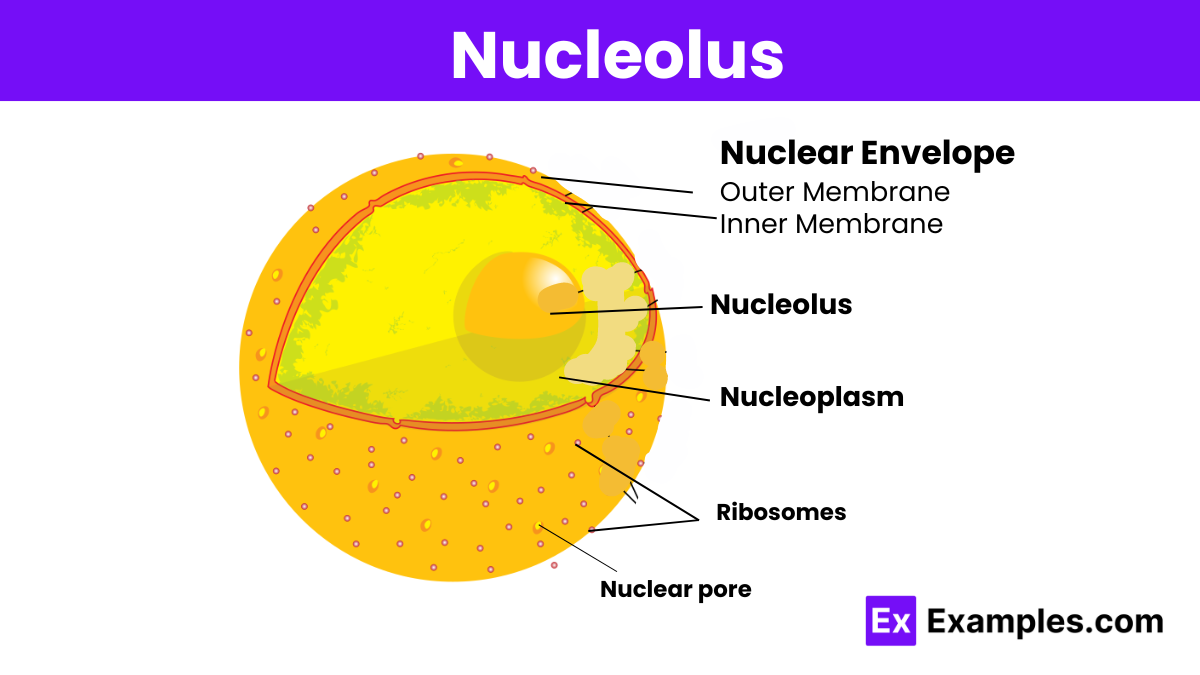What is the primary function of the nucleolus?
Ribosome production
DNA replication
Protein synthesis
Lipid synthesis


Embark on a journey into the nucleus to uncover the nucleolus, a pivotal entity in cellular function and ribosome assembly. This comprehensive guide presents the nucleolus in all its glory, from its structure to its indispensable role in synthesizing ribosomes, the cell’s protein factories. Through illustrative examples, we delve into how the nucleolus regulates protein production, impacts gene expression, and supports cell health and growth. Ideal for students, educators, and biology enthusiasts, this guide enriches your understanding of the nucleolus, offering insights into its vital contributions to life at the microscopic level.
The nucleolus is a prominent structure within the nucleus of eukaryotic cells, identifiable under a microscope as a dense area devoid of a surrounding membrane. It is not a static structure; rather, its appearance and size can change based on the cell’s metabolic activity, particularly its rate of protein synthesis. The primary function of the nucleolus is the synthesis of ribosomal RNA (rRNA) and the assembly of ribosomes, the cellular machines responsible for protein synthesis. The nucleolus forms around specific chromosomal regions called nucleolar organizing regions (NORs), which contain genes for rRNA.
The nucleolus is a prominent sub-organelle within the nucleus of eukaryotic cells, notable for its lack of a surrounding membrane. It is formed around specific chromosomal regions called nucleolar organizing regions (NORs), which contain the genes for ribosomal RNA (rRNA) synthesis. The structure of the nucleolus can be broadly divided into three main components, reflecting its functions in the production and assembly of ribosome subunits:
The dynamic structure of the nucleolus reflects its active role in ribosome synthesis and assembly. Its size and shape can vary depending on the cell’s metabolic activity, particularly the demand for protein synthesis.
The nucleolus plays several critical roles in the cell, primarily related to the production of ribosomes, which are essential for protein synthesis. Its main functions include:
The nucleus and nucleolus are integral components of eukaryotic cells, each serving distinct functions vital to cellular operations. Their differences lie not only in function but also in structure and location within the cell.
The nucleus is the command center of a eukaryotic cell, encased in a double-layered membrane known as the nuclear envelope. This envelope is punctuated with pores that regulate the flow of materials between the nucleus and the cytoplasm. Inside, the nucleus contains the cell’s genetic material in the form of DNA, which is organized with proteins into chromatin. During specific stages of the cell cycle, chromatin condenses to form visible chromosomes.
The nucleolus is a dense region within the nucleus, not enclosed by a membrane. It forms around nucleolar organizing regions on chromosomes, where genes for ribosomal RNA (rRNA) are located. The primary function of the nucleolus is to synthesize rRNA and combine it with proteins imported from the cytoplasm to assemble ribosomal subunits, which are then transported out to the cytoplasm for protein synthesis.
| Nucleus | Nucleolus |
|---|---|
| Large, typically the most prominent organelle in a cell. | Very small in comparison, located within the nucleus. |
| Bound by a nuclear envelope, consisting of two membranes. | It has no limiting membrane; it’s a region within the nucleus. |
| Contains chromosomes made of DNA and proteins. | Does not contain chromosomes but is rich in RNA. |
| Rich in DNA, the cell’s genetic material. | Primarily composed of RNA and proteins involved in ribosome production. |
| Regulates gene expression, stores genetic information, and controls cell division. | Primarily responsible for the synthesis of ribosomal RNA (rRNA) and assembly of ribosomes. |
| Present throughout the cell cycle, undergoes changes during cell division. | May vary in size and visibility depending on the cell’s activity, particularly protein synthesis. |
The nucleolus is located within the nucleus of eukaryotic cells, forming around nucleolar organizing regions on certain chromosomes.
Yes, the nucleolus is considered an organelle, specifically a non-membrane-bound organelle found within the nucleus.
Without a nucleolus, cells would fail to produce ribosomes efficiently, severely impairing protein synthesis and affecting cell growth and division.
The nucleolus plays a pivotal role in cell functionality, primarily orchestrating ribosomal RNA synthesis and ribosome assembly. Beyond its central task, it influences various cellular processes, including stress response and cell cycle regulation. This multifunctional organelle exemplifies the intricate and dynamic nature of cellular components, underpinning essential mechanisms vital for life.
Text prompt
Add Tone
10 Examples of Public speaking
20 Examples of Gas lighting
What is the primary function of the nucleolus?
Ribosome production
DNA replication
Protein synthesis
Lipid synthesis
The nucleolus is located in which part of the cell?
Cytoplasm
Nucleus
Mitochondria
Endoplasmic reticulum
Which of the following molecules is synthesized in the nucleolus?
DNA
Messenger RNA (mRNA)
Ribosomal RNA (rRNA)
Transfer RNA (tRNA)
The nucleolus is involved in the production of:
Mitochondria
Lysosomes
Golgi bodies
Ribosomes
Which type of cells typically have a prominent nucleolus?
Cells with high rates of protein synthesis
Cells in a dormant state
Red blood cells
Neurons
The nucleolus disappears during which phase of the cell cycle?
Prophase
Metaphase
Anaphase
Telophase
Nucleolar organizer regions (NORs) are associated with which chromosomes?
Chromosomes without centromeres
Chromosomes with ribosomal DNA genes
Chromosomes with telomeres
Chromosomes involved in crossing over
What is the relationship between the nucleolus and ribosomal proteins?
Ribosomal proteins are synthesized in the nucleolus
Ribosomal proteins are imported into the nucleolus
Ribosomal proteins are degraded in the nucleolus
Ribosomal proteins have no interaction with the nucleolus
Which structure within the nucleolus is responsible for rRNA transcription?
Fibrillar center
Dense fibrillar component
Granular component
Nuclear envelope
The nucleolus is best visualized using which type of microscope?
Light microscope
Electron microscope
Fluorescence microscope
Confocal microscope
Before you leave, take our quick quiz to enhance your learning!

